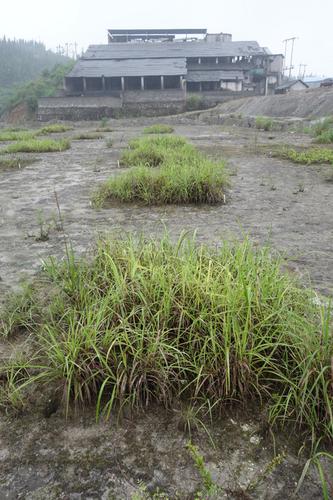当前位置:
X-MOL 学术
›
J. Appl. Ecol.
›
论文详情
Our official English website, www.x-mol.net, welcomes your
feedback! (Note: you will need to create a separate account there.)
Plant diversity enhances the reclamation of degraded lands by stimulating plant–soil feedbacks
Journal of Applied Ecology ( IF 5.0 ) Pub Date : 2020-04-30 , DOI: 10.1111/1365-2664.13625 Pu Jia 1, 2 , Jie‐liang Liang 1 , Sheng‐xiang Yang 3 , Sheng‐chang Zhang 4 , Jun Liu 4 , Zhi‐wei Liang 4 , Feng‐mei Li 5 , Qing‐wei Zeng 4 , Zhou Fang 1 , Bin Liao 4 , Wen‐sheng Shu 1 , Marc W. Cadotte 2 , Jin‐tian Li 1, 4
中文翻译:

植物多样性通过刺激植物-土壤的反馈来促进退化土地的开垦
更新日期:2020-04-30
Journal of Applied Ecology ( IF 5.0 ) Pub Date : 2020-04-30 , DOI: 10.1111/1365-2664.13625 Pu Jia 1, 2 , Jie‐liang Liang 1 , Sheng‐xiang Yang 3 , Sheng‐chang Zhang 4 , Jun Liu 4 , Zhi‐wei Liang 4 , Feng‐mei Li 5 , Qing‐wei Zeng 4 , Zhou Fang 1 , Bin Liao 4 , Wen‐sheng Shu 1 , Marc W. Cadotte 2 , Jin‐tian Li 1, 4
Affiliation

|
- Despite a rich history of theoretical and empirical work showing that increasing biodiversity results in higher ecosystem function, this research has not made a commensurate impact on the reclamation of degraded lands, where enhancing ecosystem function is of primary importance.
- In this study, we manipulated plant diversity on heavily degraded mine lands and showed that increasing plant diversity greatly enhanced the reclamation of these lands. We found that high‐diversity assemblages were often associated with more biomass, higher stability and less toxic foliage than low diversity treatments, although the monocultures of Miscanthus sinensis (the most productive species) performed equally well as some of the polycultures.
- Our results showed that species composition and richness explained most of the total variation in biomass yield of the experimental plots, indicating that both the selection and complementarity effects influenced the positive diversity effects observed in this study.
- Miscanthus sinensis and legumes (as a functional group) were found to be the main contributors to the selection effect. The plots with M. sinensis tended to harbour fewer soil fungal pathogens than those without it and a similar pattern was observed for the legumes, indicating a poorly known plant–soil fungal pathogen feedback for these plants. This kind of feedback appeared to play an important role also in shaping the positive plant species richness–ecosystem function relationships recorded in the degraded mine land. More importantly, we provide the first evidence that the observed plant–soil fungal pathogen feedbacks were likely mediated by chitinolytic bacteria that release anti‐fungal enzymes. Cellulose‐degrading bacteria that aid in plant decomposition and nutrient cycling also attained higher abundances in plots with higher plant diversity, suggesting the contribution of another kind of plant–soil feedback to the positive diversity effects.
- Synthesis and applications. Our findings reveal that highly diverse plant assemblages are better able to spur plant–soil feedbacks and that increasing plant diversity is an important strategy to enhance land reclamation efficiency after contamination. Meanwhile, our results also indicate that some plants such as Miscanthus sinensis and legumes should be preferentially used to establish diverse plant communities for rapid reclamation of degraded lands.
中文翻译:

植物多样性通过刺激植物-土壤的反馈来促进退化土地的开垦
- 尽管有丰富的理论和经验工作历史表明,增加生物多样性可提高生态系统功能,但这项研究并未对退化土地的开垦产生相称的影响,在退化土地上,增强生态系统功能至关重要。
- 在这项研究中,我们操纵了严重退化的矿区的植物多样性,结果表明,增加植物多样性大大增强了这些土地的开垦。我们发现,与低多样性处理相比,高多样性组合通常具有更多的生物量,更高的稳定性和较低的毒性叶片,尽管芒草(产量最高的树种)的单培养与某些混养表现相同。
- 我们的研究结果表明,物种组成和丰富度解释了实验地块生物量产量的大部分变化,表明选择效应和互补效应均影响本研究中观察到的积极多样性效应。
- 发现芒草和豆类(作为功能组)是选择作用的主要贡献者。与该地块M.冬虫夏草与没有真菌病原体的土壤真菌病原体相比,它们倾向于携带更少的真菌病原体,而且豆科植物观察到的模式相似,表明这些植物的植物土壤真菌病原体反馈知之甚少。这种反馈似乎在塑造退化矿山中记录的积极的植物物种丰富度-生态系统功能关系中也起着重要作用。更重要的是,我们提供了第一个证据,即观察到的植物-土壤真菌病原体的反馈可能是由释放抗真菌酶的几丁质分解细菌介导的。有助于植物分解和养分循环的纤维素降解细菌在植物多样性更高的地块中也获得了更高的丰度,表明另一种植物-土壤反馈对积极的多样性影响做出了贡献。
- 综合与应用。我们的发现表明,高度多样化的植物组合能够更好地刺激植物-土壤的反馈,而增加植物多样性是提高污染后土地复垦效率的重要策略。同时,我们的结果还表明,应优先使用某些植物(如芒草和豆科植物)来建立多样化的植物群落,以快速开垦退化土地。











































 京公网安备 11010802027423号
京公网安备 11010802027423号